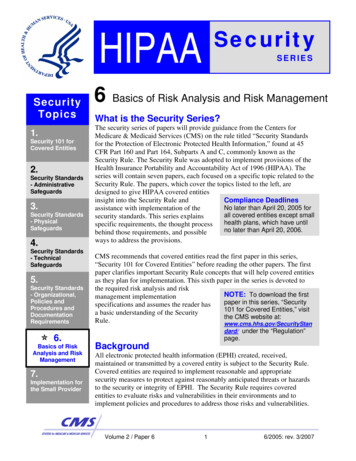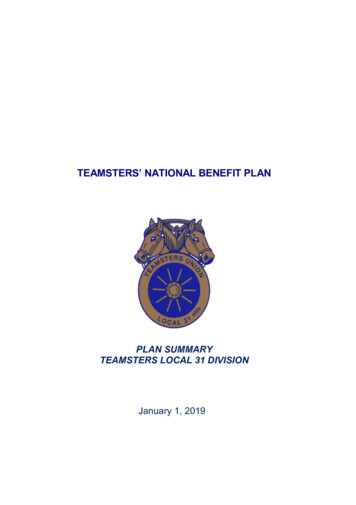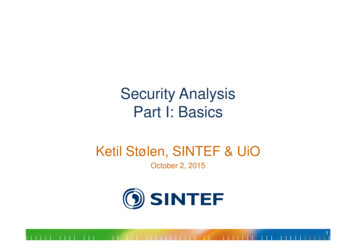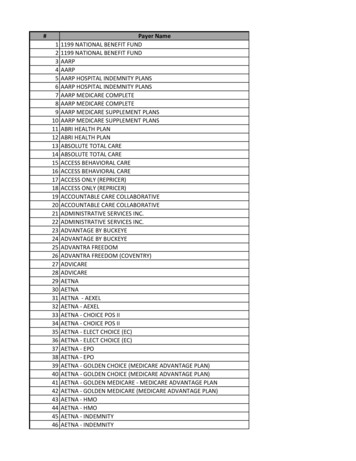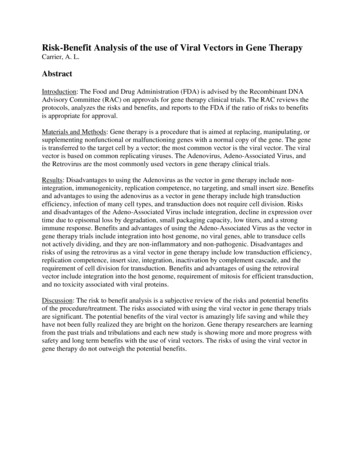
Transcription
Risk-Benefit Analysis of the use of Viral Vectors in Gene TherapyCarrier, A. L.AbstractIntroduction: The Food and Drug Administration (FDA) is advised by the Recombinant DNAAdvisory Committee (RAC) on approvals for gene therapy clinical trials. The RAC reviews theprotocols, analyzes the risks and benefits, and reports to the FDA if the ratio of risks to benefitsis appropriate for approval.Materials and Methods: Gene therapy is a procedure that is aimed at replacing, manipulating, orsupplementing nonfunctional or malfunctioning genes with a normal copy of the gene. The geneis transferred to the target cell by a vector; the most common vector is the viral vector. The viralvector is based on common replicating viruses. The Adenovirus, Adeno-Associated Virus, andthe Retrovirus are the most commonly used vectors in gene therapy clinical trials.Results: Disadvantages to using the Adenovirus as the vector in gene therapy include nonintegration, immunogenicity, replication competence, no targeting, and small insert size. Benefitsand advantages to using the adenovirus as a vector in gene therapy include high transductionefficiency, infection of many cell types, and transduction does not require cell division. Risksand disadvantages of the Adeno-Associated Virus include integration, decline in expression overtime due to episomal loss by degradation, small packaging capacity, low titers, and a strongimmune response. Benefits and advantages of using the Adeno-Associated Virus as the vector ingene therapy trials include integration into host genome, no viral genes, able to transduce cellsnot actively dividing, and they are non-inflammatory and non-pathogenic. Disadvantages andrisks of using the retrovirus as a viral vector in gene therapy include low transduction efficiency,replication competence, insert size, integration, inactivation by complement cascade, and therequirement of cell division for transduction. Benefits and advantages of using the retroviralvector include integration into the host genome, requirement of mitosis for efficient transduction,and no toxicity associated with viral proteins.Discussion: The risk to benefit analysis is a subjective review of the risks and potential benefitsof the procedure/treatment. The risks associated with using the viral vector in gene therapy trialsare significant. The potential benefits of the viral vector is amazingly life saving and while theyhave not been fully realized they are bright on the horizon. Gene therapy researchers are learningfrom the past trials and tribulations and each new study is showing more and more progress withsafety and long term benefits with the use of viral vectors. The risks of using the viral vector ingene therapy do not outweigh the potential benefits.
IntroductionThe Food and Drug Administration (FDA) has the job of protecting the public health byassuring the safety and effectiveness of the drugs, devices, and biologics that are used to treatdiseases and disorders. Before the FDA will approve a drug/device/biologic for entrance intoclinical trials the sponsor must demonstrate that it has a favorable risk to benefit ratio. A benefitis defined as a valued or desired outcome or an advantage. A risk is the probability of harm orinjury whether it is physical, psychological, social, or economic that occurs as a result ofparticipation in a research study. The risk in a clinical research trial is evaluated on a scale fromminimal to significant. Minimal risk is where the probability and magnitude of harm ordiscomfort anticipated in the trial are not greater, in and of themselves, than those ordinarilyencountered in daily life or during the performance of routine physical or psychologicalexaminations or tests.1There are many points to consider when analyzing the risks and benefits of a clinical trial.The first and most important is to accurately identify, evaluate, and describe both the risks andanticipated benefits. The next would be to determine where the risks fall on the scale fromminimal to significant. It is also important to separate the procedure from the therapeutic agentand analyze its risks and benefits independently. On October 7, 1974 the National Institute ofHealth (NIH) established the Recombinant DNA Advisory Committee (RAC) in response topublic concerns regarding the safety of manipulating genetic material through the use ofrecombinant DNA techniques.2 Since its establishment it has served as a federal advisorycommittee in the approval of gene therapy clinical trials and has been instrumental in analyzingthe risks and benefits associated with the proposed trials.Materials and Methods
Gene TherapyGene therapy is a procedure that is aimed at replacing, manipulating, or supplementingnonfunctional or malfunctioning genes with a normal copy of the gene. The therapeutic gene isinserted into the target cell by use of a vector. Vectors that have been used include viruses,liposomes, and naked DNA and RNA molecules. Viruses are the most commonly used vectors asis evidenced by their use in 66.2% of all clinical trials. (Chart 1)Chart 1: This pie chart shows the percentage of clinical trials in which each vectorhas been used. 3A viral vector is a delivery system that is based on replicating viruses that have the abilityto deliver genetic information into a host cell.4 The virus is a strict intracellular parasite that canonly replicated within a host cell and its life cycle is what makes it an ideal candidate for use as avector. The viral life cycle includes attachment, penetration, uncoating, macromolecularsynthesis, and release. A virus attaches to a host cell by recognition of receptors on the cellssurface. This receptor recognition system determines the type of cell that the viral vector cantransduce since not all body cells have the same receptors at the same levels.Penetration is the process by which the virus enters the cell; this can be achieved bymembrane fusion or endocytosis. Membrane fusion penetration occurs when the viral envelopefuses with the host cell membrane allowing the contents of the envelope to enter the cell. In the
endocytosis method of penetration the virus recognizes receptors on the cell’s surface, attaches tothese receptors, and becomes engulfed by the cell. Membrane fusion is the method of entry forenveloped viruses, such as the retrovirus. Endocytosis penetration is favored by the nonenveloped viruses, such as the adenovirus or the adeno-associated virus. Once inside the host celluncoating of the virus occurs. A process necessary for the release of the viral genome and occursbefore the viral DNA or RNA can be delivered to the intracellular replication site.Production of the nucleic acid and protein structures are included in the macromolecularsynthesis phase. This includes replication of the viral genome and synthesis of viral structures.The next phase of the viral life cycle is viral assembly where the viral genome gets packaged intothe capsid. The enveloped viruses attain their envelope from the host cell membrane through aprocess called budding. The final phase is the release of the newly formed viruses from the hostcell into the organism to travel to and infect other cells and repeat the cycle. Enveloped virusesbud from the cell membrane while the non-enveloped virus lyses the host cell.This final phase of the viral life cycle is not conducive to most gene therapy protocols. Inorder to maintain expression of the transferred gene the virus must be modified so that it remainsin the latent infection model. Modification starts with the removal of all or some of the viralcoding DNA and insertion of the therapeutic gene. The genes that were removed from the wildtype virus that are involved in replication or capsid/envelope proteins are inserted into apackaging construct to assist in trans. The packaging cells are co-transfected with the vectorgenome and packaging construct to produce recombinant vector particles which can be purifiedand quantified.5 (Figure 1)6
Figure 1: Schematic of the procedure for turning a wild-type virus into a vectorfor gene therapy.AdenovirusThe adenovirus is a small non-enveloped icosahedral virus that contains a linear doublestranded DNA genome. The coding region of the genome is flanked by inverted terminal repeats(ITRs) and contains two sets of transcription regions. The early transcription region contains fivegene regions: E1A, E1B, E2, E3, and E4. The single late transcription region generates a familyof five late mRNAs (L1-5). The early and late transcription regions correlate to the two phases ofAd replication cycle. In the early phase the viral DNA gets transported to the nucleus wheretranscription of the early genes is initiated. The gene products of this phase interfere with thehost cell’s antiviral defense mechanism and direct the cell to enter into mitosis. The induction ofthe cell cycle signals the start of the late events in Ad replication. The late phase is characterizedby an increase in the gene expression of mRNA regulated by the late promoter resulting in highproduction of structural proteins and assembly of new virions. The induction of cell lysis releasesthese virions from the cell.7 (Figure 2)
Figure 2: A. Schematic of the genome of a wild-type Adenovirus. B. Schematic ofthe genome of a gutless Adenoviral Vector and the genome of the helper virus. C.Schematic of the production of the Adenoviral Vector.7Adeno-Associated VirusThe adeno-associated virus (AAV) is a small non-enveloped virus from the familyparvoviridae, subfamily dependovirus. The genome is a linear 4.7 kb single-stranded DNAmolecule that has two open reading frames, rep and cap. Cap encodes the structural proteins thatform the capsid while rep encodes the regulatory proteins. AAV enters the cell throughendocytosis and the DNA transported to the nucleus after uncoating. Once in the nucleus thesingle-stranded DNA is replicated to form double-stranded DNA which then integrates by nonhomologous recombination into a specific location on chromosome 19. AAV will remain in asilent or latent infection profile for the life of the cell. The adeno-associated virus is nonpathogenic and cannot replicate independently. However, replication and dissemination of thevirus can occur in the presence of a helper virus. It is the gene products of this unrelated helpervirus, usually adenovirus or herpes virus, which promotes the replication of the adeno-associatedvirus.7 (Figure 3)
Figure 3: A. Schematic of the genome of a wild-type Adeno-Associated virus. B.Schematic of an Adeno-Associated viral vector and the genome of the packagingand helper construct. C. Schematic of the production of the Adeno-AssociatedViral Vector.7RetrovirusThe term retrovirus refers to any of a family of viruses that has an RNA genome and usesthe enzyme reverse transcriptase during its life cycle. These viruses are enveloped and contain 2copies of the single-stranded RNA genome in an icosahedral capsid. The genome contains atleast three genes (gag, pol, and env) which are flanked by long terminal repeats (LTRs). The gaggene encodes the core proteins, capsid matrix, and nucleocapsid. The pol gene encodes theenzymes protease, reverse transcriptase, and integrase and is usually derived from the gag-polprecursor. The env gene encodes the envelope glycoproteins that mediate cell entry. Cell entry isachieved by the membrane fusion method. The ssRNA genome, upon uncoating, is convertedinto double stranded proviral DNA by reverse transcriptase. The proviral DNA is the transportedto the nucleus where it is randomly integrated into the host genome mediated by the enzymeintegrase. The host cell’s transcription factors initiate transcription of the integrated genes andnew viral particles are formed. The precursors of gag-pol and gag assemble together with thetwo copies of viral single stranded RNA while the env glycoproteins are incorporated into the
membrane during the budding process. Virus maturation occurs when the enzyme proteaseprocesses the gag and gag-pol precursors. (Figure 4)Figure 4: A. Schematic of the HIV-1 based Lentiviral Vector genome and thegenomes of the packaging constructs. B. Schematic of the production of theLentiviral Vector.7This large family of viruses can be sorted into three classes: oncoretroviruses,lentiviruses, and spumaviruses. The oncoretrovirus is the simplest of the three and contains onlythe gag, pol, and env gene flanked by the LTRs. Examples of oncoretroviruses include themurine leukemia virus (MLV), spleen necrosis virus, Rous sarcoma virus, and avian leucosisvirus. The lentiviruses and spumaviruses contain additional viral genes making them morecomplex than the oncoretroviruses. In the lentivirus sub family there are three to six additionalviral proteins that are essential to the replication of the virus and persistence of the infection.Only two of the additional genes, tat and rev, are present in all lentiviruses. These proteinsmediate the transactivation of viral transcription and nuclear export of unspliced viral RNA,respectively. An example of a lentivirus is the human immunodeficiency virus type 1. Thespumaviruses are also called foamy viruses and contains three open reading frames (ORFs) inaddition to the structural proteins. These three ORFs include tas/bel-1, bel-2, and bel-3. The ORFtas/bel-1 has been identified as a co-activator of viral transcription.7 (Figure 5)
Figure 5: A. Schematic of the genome of the Murine Leukemia Virus (MLV)genome. B. Schematic of the HIV-1 genome. C. Schematic of the Foamy Virus(FV) genome.7ResultsAdenoviral VectorRisksDisadvantages to using the Adenovirus as the vector in gene therapy include nonintegration, immunogenicity, replication competence, no targeting, and small insert size.8 TheAdenovirus genome remains as an episome and does not integrate into the host cell genome.Thus making its effects transient as it is not passed on to daughter cells during mitosis. This alsonecessitates continuous readministration over the course of a long period of time, possibly as amaintenance drug. Readministration can lead to the development of an immune response.Immunogenicity is the biggest problem with the Adenoviral Vector as it is ubiquitous in thenatural population. Also because it can be found in nearly all patients it is possible for the virusto recombine with viral genome existing in the cell to form replication competent virus particlesthat can then cause a systemic infection in the patient.The Adenovirus can infect numerous types of human cells which can be bothadvantageous and disadvantageous because this makes it possible to transduce the wrong celltype. Unintended transduction can cause cell toxicity and cell death. It would also be possible for
the Adenovirus to infect germ line cells which would pass any changes on to the patient’soffspring which is prohibited by the FDA. The genome of the adenovirus is approximately 35 kband a packaging capacity of 8 kb in replication defective vectors up to 30 kb in helper dependentvectors. The average human gene is approximately 3000 base pairs however it variessignificantly and can contain up to 2.4 million base pairs (dystrophin). Cystic Fibrosis andHemophilia are two single gene mutation diseases that are being researched for possible genetherapy trials. Cystic Fibrosis Trasmembrane Conductase Regulator (CFTR) is a 230 kb genethat upon mutation causes the disease Cystic Fibrosis (CF).9 Hemophilia A is caused bymutations in the F8 gene which spans 186 kb of genomic DNA and has a coding region of 9.1kb.10 These are just two examples of how large a human gene can be compared to the packagingcapacity of the viral vector.Gene therapy using viral vectors had its first major setback in 1999 when 18 year oldJesse Gelsinger died as a direct result of the adenovirus that was used to deliver the gene. Jessehad a mild form of ornithine transcarbamylase (OTC) deficiency which is a disorder of nitrogenmetabolism which was being treated with a drug and diet regimen. On September 13th 1999 Jessereceived an injection of 3.8x1013 adenoviral vector particles, the largest dose in a gene therapytrial. He died four days later from a systemic inflammatory immune response that caused fever,disseminated intravascular coagulation (DIC), and multiorgan failure.11The immune response seen in Jesse’s case is not the only type of response that ispossible. In a study evaluating the osteoinductive activity of an adenoviral vector carrying theBMP-2 gene expression of the transgene was only detected in nude, or immunosuppressed rats.Osteoinduction was not seen in the normal immunocompetent population of rats due to a T cellimmune response. The immune response did not lead to a systemic life threatening condition as
in the Jesse Gelsinger case however it prevented the adenoviral vector from reaching its targetcell.12Researchers have attempted to harness the cytotoxic effects of the wild-type adenovirusby modifying it to conditionally replicate only in tumor. Theoretically, upon infection of thetumor cells the normal life cycle of the virus will take over the cell leading to cell lysis and deathof the tumor cell and subsequent infection of the surrounding tumor cells. Onyx-015, an E1battenuated adenovirus, was injected directly into the tumor of patients with recurrent head andneck cancers in a phase I clinical trial.13 Nearly all of the patients in the trial (21 of 22) showedan increase in the neutralizing antibody to the adenovirus and only 4 of the 22 patients showedviral replication. No objective responses were observed in any of the patients. These negativeresults were a result of limited intratumoral spread of the replicating virus due to the presence ofthe neutralizing antibody.Human physiology has also been a limitation in the systemic use of adenoviral vectors.The virions have a short half life in the human body due to removal from circulation by theKupffer cells of the reticuloendothelial system.14 The Kupffer cell is the macrophage of the liver;it takes up foreign particles that pass through the liver including viruses, toxins, and drugs.Unfortunately, the uptake of the vectors by the Kupffer cells does not result in transgeneexpression thus decreasing the overall efficiency of the therapy. Additionally, thereticuloendothelial system is part of the immune system and contributes to the innate immuneresponse to the adenoviral vector particles.BenefitsBenefits and advantages to using the adenovirus as a vector in gene therapy include hightransduction efficiency, infection of many cell types, larger packaging capacity, and transduction
does not require cell division.9 In comparison to other viruses used as vectors, the Adenoviralvector has the largest packaging capacity. Transduction of non-dividing cells is a significantadvantage to the use of the adenoviral vector. The majority of cells in the human body are notactively going through cell division, making it disadvantageous for vectors that can onlytransduce during mitosis. The ability to transduce non-dividing cells is advantageous for theadenovirus because of its inability to integrate into the host genome. In cells that are activelydividing the transgene is often lost because it is not replicated and passed on to daughter cells.Production of the adenoviral vector can be done with little manipulation and significantlyhigh titers can be achieved. However, it has also been shown that minimal levels of the virus canachieve high levels of transduction of cells and still generate efficient levels of gene expression.Adenoviral vector transgene expression has been documented in several different body tissuesincluding muscle cells12, pancreatic islet cells15, respiratory tract epithelia cells16, and evencorneal epithelia cells.17 Several animal studies have been conducted that were concluded toshow safety and efficacy of gene therapy using the adenovirus and the gene delivery vector. Twoexamples are detailed below.The Adenovirus has also shown some antitumor effectiveness. In an animal safety andefficacy study on Adenovirus-mediated Interleukin-24 expression in a mouse model showedretarded tumor growth and reduced microvessel density (MVD) and vascular endothelial growthfactor (VEGF) expression in tumors. The response seen by the mouse tumors in this study waselicited by Ad-IL-24 and was an induction of apoptosis in the laryngeal cancer cells andinhibition of tumor angiogenesis. Researchers in this study concluded that the Adenoviralvector’s potent yet selective killing activity of the cancer cells while sparing the normal cellsmakes the vector a candidate for cancer gene therapy in humans.18
The third most common disease and the fourth leading cause of death in North Americais Diabetes. Treatment can range from diet and exercise for borderline Type II diabetics to dailyinsulin injections for Type I diabetics. Permanent destruction of the insulin-producing beta cellsis the characteristic presentation of Type I diabetes. One option for insulin-dependent patients istransplantation of the pancreas. As with any major organ transplantation a regimen ofimmunosuppressant drugs must be taken for the lifetime of the patient. Transplantation ofpancreatic islet cells is safer and less invasive yet has been hindered by graft malfunction andfailure. Researchers in an animal study have tested a gene therapy technique involving anadenovirus-mediated TNF (tumor necrosis factor)-related apoptosis-inducing ligand (TRAIL)gene delivered into pancreatic islets to attempt to resist autoreactive T cell assault.15 Theresearchers concluded that TRAIL over expression in pancreatic islets extended the allograftsurvival and function and lead to a therapeutic benefit in the rats.Adeno Associated VirusRisksRisks and disadvantages of the Adeno-Associated Virus include integration, decline inexpression over time due to episomal loss by degradation, small packaging capacity, low titers,and a strong cell-mediated immune response. The Adeno-Associated virus is a small virus with aprimitive genome that contains only 2 genes. Thus the packaging capacity is also extremelysmall, approximately 4 to 5 kb. Adeno-Associated Viral vectors are produced in packaging celllines with the assistance of helper viruses, such as the Adenovirus. This process is inefficient asit does not yield high titers and is frequently contaminated by the helper virus.8 Titers of AAVvectors seen rarely exceed 104 viral particles. Contamination with the helper virus may also leadto an immune response, especially in cases where the adenovirus is the helper. Another major
barrier to the use of the AAV vector is inefficient transduction due to necessary conversion of thesingle-stranded DNA genome into a double stranded molecule. This not only delays theintegration and/or expression of the transgene it can also lead to mutations in the newly formedstrand that can lead to an ineffective protein or neoplastic proliferation.As discussed in regards to the Adenoviral vector, transgenes that remain as episomesinstead of integrating into the host genome are at the risk of being lost or degraded when that cellundergoes mitotic division. This is not only a disadvantage of using the AAV as the vector it isalso a risk to the patient. If the transgene is lost the cell stops producing the normal protein andthe disease or disorder can recur. This necessitates the switch to another form of therapy orreadministration of the vector carrying the transgene. In the case of the AAV vector,readministration may cause a cell mediated immune response if memory cells were developedagainst the vector.The Adeno-Associated Viral vector is ubiquitous as evidenced by the fact that 80 – 90%of the population becomes infected with it during childhood. It is also thought to be innocuousbecause it usually remains in the latent infection state unless in the company of a helper virusand has only 2 viral genes. However, 29 different adverse events have been reported in 12 USclinical trials using the Adeno-Associated Virus as the vector for gene delivery, according to theRAC.19 It has been discovered that while the Adeno-Associated Virus does not cause a humoralimmune response as is seen in the Adenovirus it can lead to a cell-mediated immune response.An animal study conducted to evaluate the use of the Adeno-Associated Virus serotype 7in gene therapy of the liver. This study was conducted using primates to evaluate the relevanceof results seen in the murine liver. A vibrant cytotoxic T cell response to the expressed greenfluorescence protein (GFP) that was correlated with hepatitis and loss of expression was
observed in the primate trial that was not seen in the murine trials. It was concluded that undersome conditions the primate immune response may react with more aggressive T cell response tothe transgene products than was observed in the mice.20 This would lead a researcher to questionthe response that might be seen in human patients. Since the human is more physiologicallysimilar to the primate than to the mouse one could hypothesize that the T cell response wouldemulate that seen in the primate.Integration can cause a problem in gene therapy if the transgene integrates into an activegene or in a region that can promote the activation of an oncogene. The wild-type AAV has atargeted integration at a site on chromosome 19, however upon removing of the rep gene toinsert a therapeutic gene the targeted integration is lost. A recent study has shown thatrecombinant Adeno-Associated Viruses (rAAV) have a preference for integrating into functionalgenes. This could be considered an evolutionary tactic developed by viruses because integrationinto an active gene would most likely ensure replication and spread of infection.The integration of the rAAV is frequently associated with chromosomal rearrangementsand deletions of large segments of the DNA. The integration of the rAAV genome is thought tooccur through non-homologous end-joining (NHEJ) of the rAAV free ends to brokenchromosome ends that has lead researchers to question if the rAAV causes the breaks or merelytakes advantage of pre-existing breaks. Research has suggested that it is the latter of the twotheories. Introduction of genotoxic agents that are known to induce double-strand breaks into cellcultures an increase in rAAV integration is observed. It has also been demonstrated thatincreasing the rAAV vector dose above a threshold level does not increase the number ofintegrations.5Benefits
Benefits and advantages of using the Adeno-Associated Virus as the vector in genetherapy trials include integration into host genome, no viral genes, able to transduce cells notactively dividing, wide range of host cells, and they are non-inflammatory and non-pathogenic.5 7To produce an Adeno-Associated Viral vector, all viral genes are removed to allow room for thetherapeutic gene. Removal of all genes creates a space for a larger insert and decreases the risk ofan immune response to viral gene products. Transduction of non-dividing cells, as detailed in theadenovirus section, allows for continued expression of transgenes that do not integrate into thehost genome. Adeno-Associated Viruses have the distinction of being the only wild-type virusused for gene therapy that is not pathogenic in humans. It is also by itself non-replicating and canonly enter the viral life cycle in the case of co-infection with a helper virus.Approximately 10% of in vivo transduction cases, the transgene will integrate into thehost cell genome.5 This is advantageous when transducing cells that are undergoing mitosis andallows for passing the gene on to daughter cells. The AAV integration is unique in that the wildtype virus will integrate at a specific site on chromosome 19. This feature is advantageousbecause it means that researchers would know exactly where the virus integrates. However,because this is mediated by the rep gene, once the gene is removed the targeted integration doesnot occur.21 Leaving the rep gene in the vector would retain the targeted integration however itwould decrease the insert size which is already quite small. Random integration can still occureven in the absence of the rep gene.Researchers have developed ways to expand the delivering capabilities of the AAVvector. One of these methods is referred to as trans-splicing which is a dual-AAV vector systemand involves splitting the transgene into two separate AAV vectors that splice together in thetarget cell. Researchers in an animal study have harnessed trans-splicing to treat mice with
Duchene Muscular Dystrophy. Body-wide transduction of muscle cells in normal neonatal micewas demonstrated using tsAAV serotype 9. Robust transduction was seen in the heart of thesemice and the apparent lack of proactive cellular immune response suggests that the AAV vectormay hold great promise for treating human Duchene cardiomyopathy and X-linked dilatedcardiomyopathy. 22The Adeno-Associated Viral vector is capable of transducing several cell types. One oftheses types of cells is the hepatocyte. An animal study was conducted to determine the ability ofthe Adeno-Associated Viral vector to transduce hepatic cells for use in treatment of diabetesmellitus. This research trial was conducted using diabetic mice which were infected with anAAV vector carrying a gene for insulin expression with a glucose initiated promoter sequence.When the promoter was activated by glucose in the mice’s blood the gene for insulin secretionwas transcribed. The rAAV efficiently transduced the hepatic cells and the transgene wassubsequently expressed resulting in regulation of the blood glucose level in the diabetic mice.This study suggests that the rAAV has the potential for being an effective gene therapy treatmentof diabetes mellitus.23Another cell type that the AAV vector can transduce is the muscle cell as wasdemonstrated in
inserted into the target cell by use of a vector. Vectors that have been used include viruses, liposomes, and naked DNA and RNA molecules. Viruses are the most commonly used vectors as is evidenced by their use in 66.2% of all clinical trials. (Chart 1) Chart 1: This pie chart shows the percentage of clinical trials in which each vector




